Family : Scaridae

Text © Giuseppe Mazza

English translation by Mario Beltramini
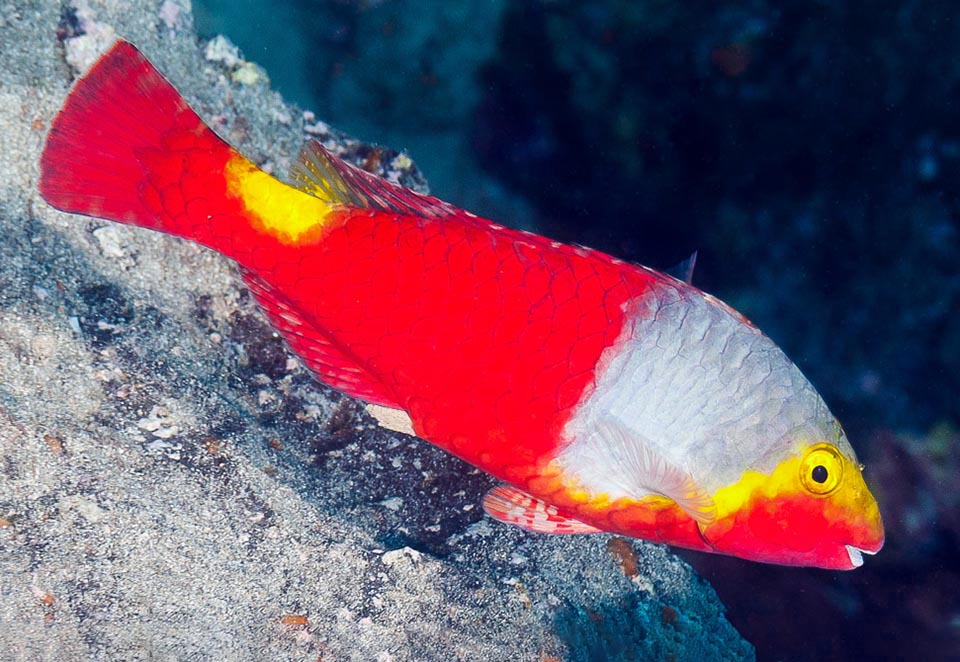
Usually 30 cm long with with a maximum of 50 cm, Sparisoma cretense is the only Mediterranean scarid © Francois Libert
Sparisoma cretense (Linnaeus, 1758) belongs to the class of the Actinopterygii, the ray-finned fishes, to the order of the Perciformes and to the colourful family of the Scaridae, the so-called parrotfishes that were already present in the lower tertiary Eocene and are now present mainly in the tropics with about ten genera and one hundred species.
The genus Sparisoma comes from “sparus”, name the Romans gave to an edible fish, darting and sparkling like the javelin, assigned by Linnaeus to the Gilt-head bream (Sparus aurata), and from the old Greek “σῶμα” (soma), body, and consequently literally means “with the body of a sparus” because its shape, longer than that of the other parrotfishes, that reminds here, in its whole, that of the Sparidae. The specific term cretense, of Crete, refers to the large Greek island, where it is very frequent.
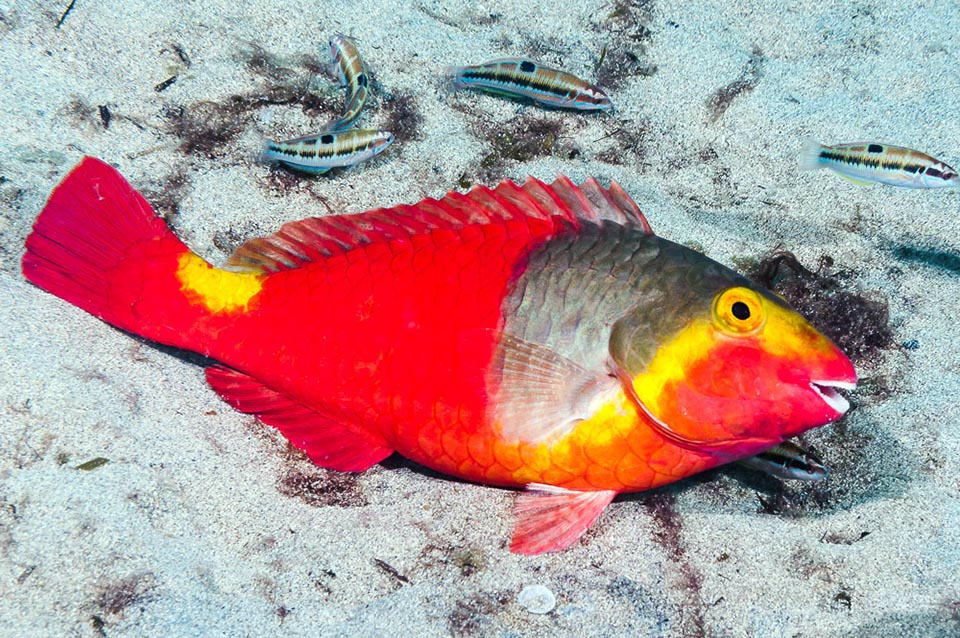
Unlike usual, it’s the female having the most showy colour, with yellow and bright red parrot like shades that turn off only in the night livery © Francois Libert
Zoogeography
Although it is known as Mediterranean parrotfish, because it is the only existing Scaridae, Sparisoma cretense is found also along the eastern temperate and tropical Atlantic coasts. In fact, it is present from Portugal, Açores, Madeira, Canary Islands and Cape Verde up to Senegal and finally in Angola.
Ecology-Habitat
Sedentary, it usually goes swimming in shallow waters, even if, at times, it has been seen at about 50 m of depth.
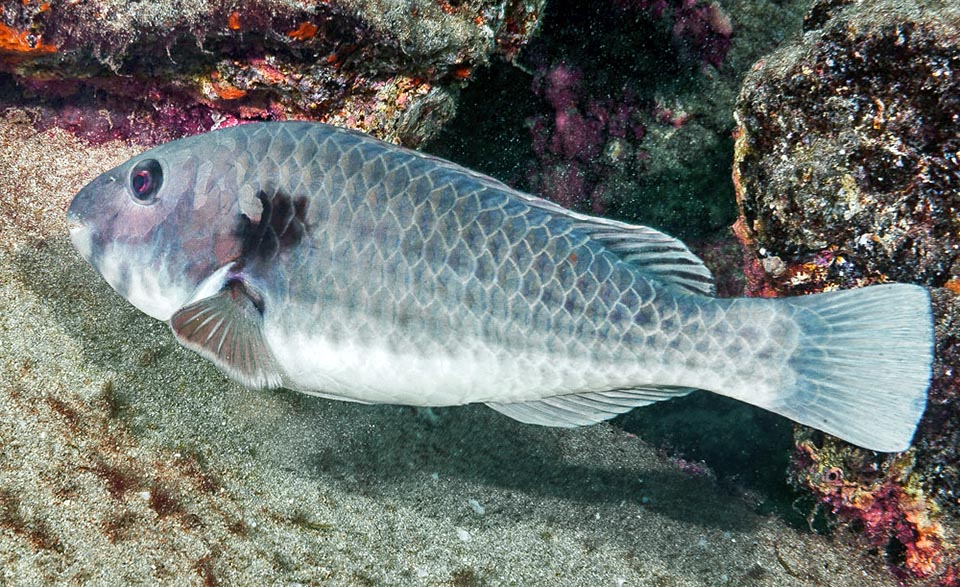
Conversely, male has a faded grey livery, tending brown or greenish, with a characteristic black spot over the pectoral fins © Francois Libert
It frequents rocky, madreporic environments and the the prairies of posidonia close to the sandy bottoms, that enriches, like all scarids, grinding algae for a long time together with their support. This had already been noticed by Aristotle who defined it, comparing it to the bovines, a “ruminant fish”.
Morphophysiology
Sparisoma cretense can reach half a metre, but the normal size is about 30 cm.
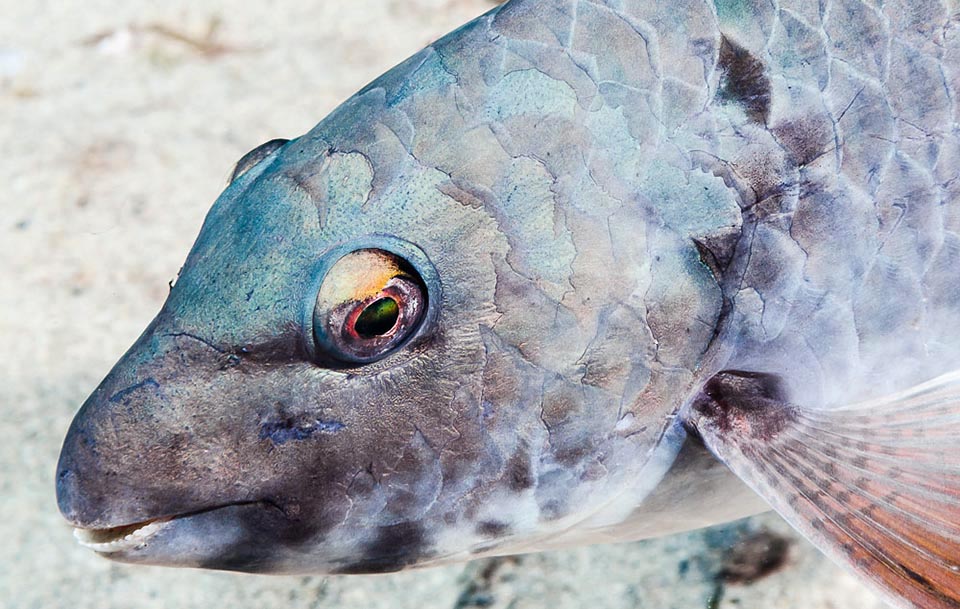
We note also two dark bands on the chin but if it wasn’t for the big scales typical of parrotfishes, in Mediterranean it might be mistaken with other species © Francois Libert
The snout is rounded. The maxillary teeth, fused together in two plates, form one solid white beak good for scraping rocks or madrepores, depending on the zone where they live. Then follow, inside the mouth, several pharyngeal teeth, similar to molars, for grinding the pick. They are carried high, on two bands, by two bones that are leaning on the base of the skull whilst, below, they appear arranged in mosaic on a single bone.
Only one dorsal fin is present that starts at the height of the pectoral ones with 10 spiny rays and 10 soft. The anal, shorter, has 2 spiny rays and 10 unarmed and the pectoral have 12 soft rays. The pelvic fins, with 1 spiny ray and 5 soft are rounded at the apex and the caudal fin, with 15-19 rays, is covered in the first part by the scales of the big peduncle. When folded it seems truncated but when it is stretched out, we note that it is slightly roundish.
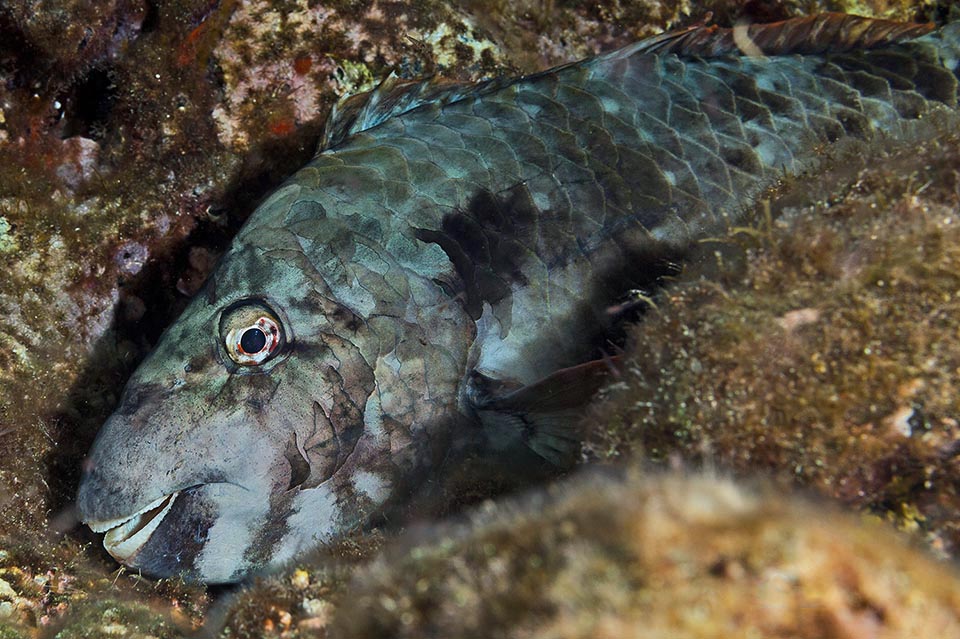
This is its mimetic night livery, that shows very well inter alia the maxillary teeth fused together forming a beak © Gaël Desroches
There is a strong sexual dimorphism and, quite rarely, the females are much more coloured than the males.
They stand out due to the bright red body with a vast grey zone that starts from the yellow band crossing the eyes of analogous colour and reaches above the first rays of the dorsal. There is then one luminous yellow spot in the upper part of the caudal peduncle and the fins are red, but the pectoral ones, greyish as the body on which they lay with some white small dots.
Conversely, the males are grey, tending to brown or greenish, with a black spot over the pectoral fins and two dark bands on the chin. The eye is grey or reddish.
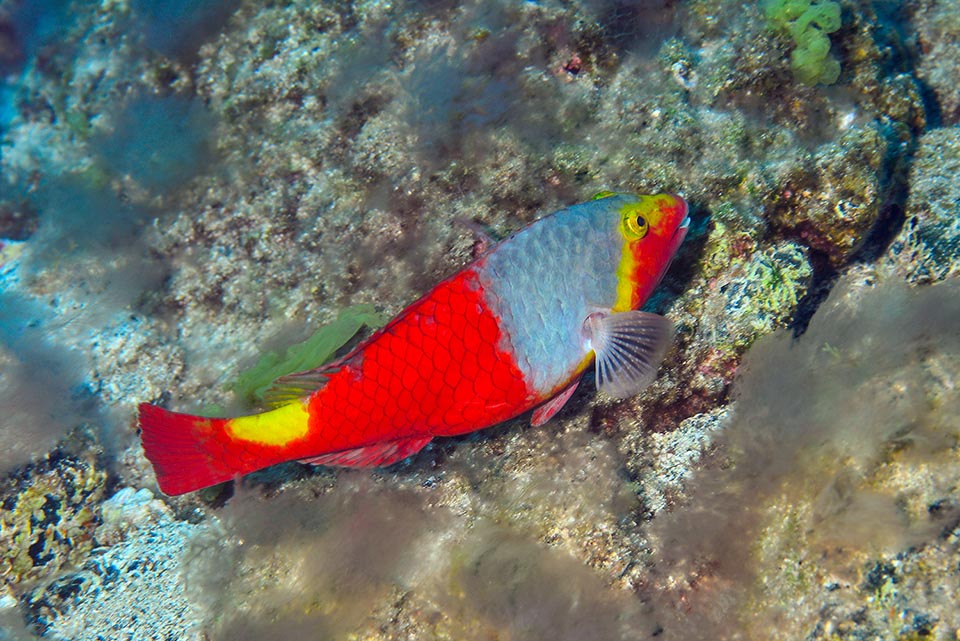
Grazing female. The encrusting algae are taken at the root, wit part of rock or of madrepore if it is swimming in tropical environments such as in Angola © Carlos Faria
At first sight, they could be mistaken with other Mediterranean species such as Labrus merula or Symphodus tinca, but they distinguish, approaching them, due to the large cycloid imbricate scales typical of the Scaridae.
Unlike most of the Scaridae with females that while growing may transform in males, the Mediterranean Parrotfish is a gonochoric species, with individuals that once reached the sexual maturity maintain the same sex for the whole life. The males and the females having the same age, in fact, do have the same size.
During the night the males as well as the females change colour, for sleeping among the algae camouflaged with the bottom.
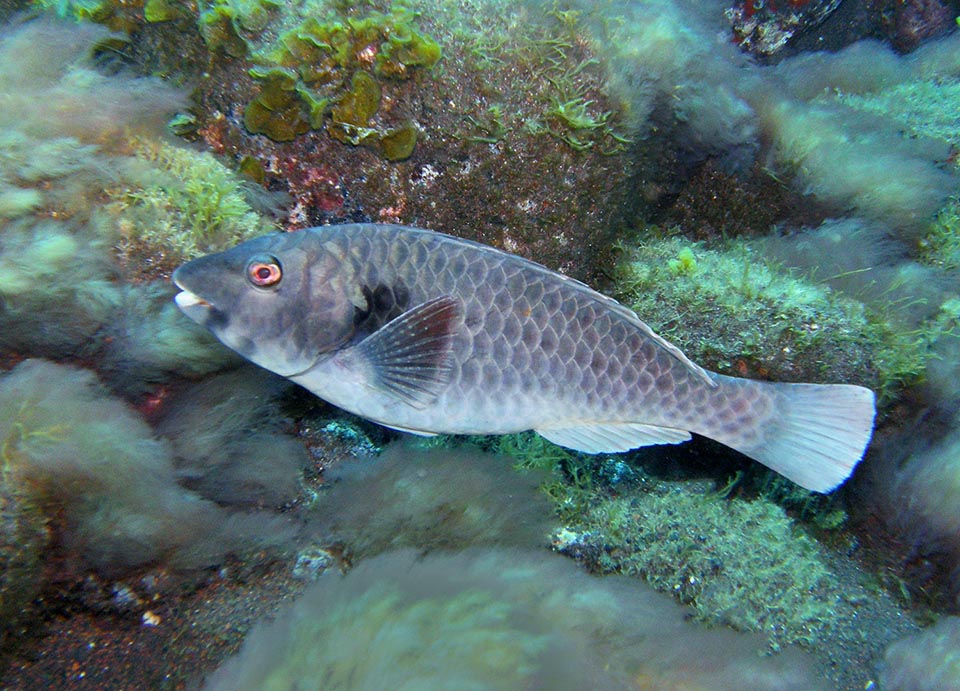
All is then ground long time by several pharyngeal teeth, similar to molars, so much the Aristotle thought it was a ruminant fish © Sergio González
The first ones get darker adding other black spots and some white ones, whilst in the females the yellow turns grey and the brown red with mimetic grey-greenish spots.
Ethology-Reproductive Biology
Sparisoma cretense is an herbivorous species that feeds by scraping off the encrusting algae, including the coral ones, and chewing posidonias, not forgetting the small invertebrates living there or that it finds while grazing. It often goes swimming in small schools mixed with other species.
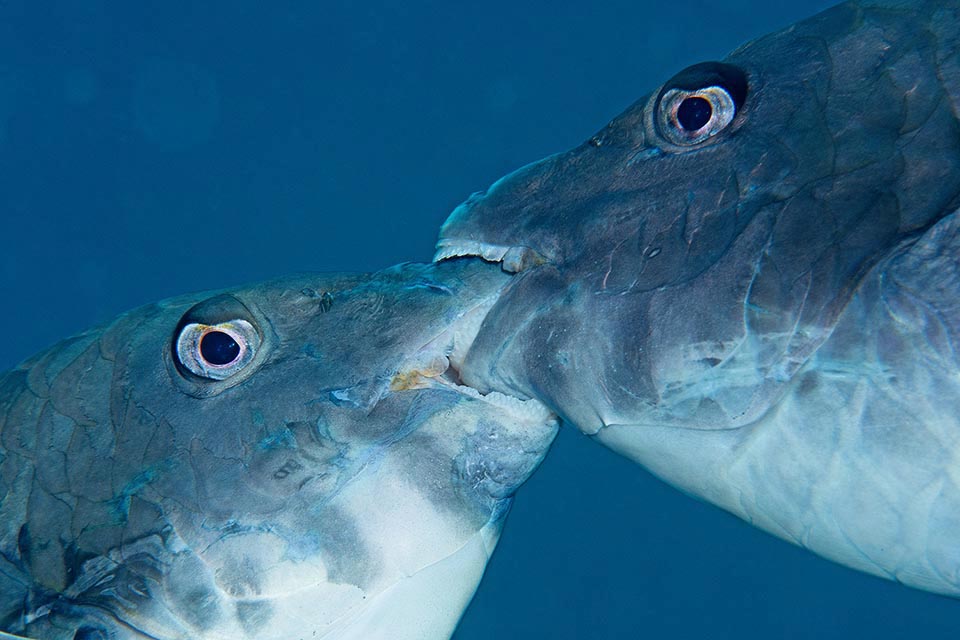
Males territorial dispute. The big ones hold a territory and a small harem, but there are also groups of itinerant males that fecundate occasionally the females ready to lay © Belén Caro
During the reproductive time, that goes in the Mediterranean from July to September, and elsewhere from May to December, there are two possibilities of mating.
In fact, we note old males with a small harem and a territory they defend with their beaks all over the year, and groups of itinerant males that, if the occasion arises, happily fecundate the passing-by females ready for laying.
Mating usually occurs at dawn or at sunset and can be single or in groups. The floating eggs and the larvae are pelagic for about two months.
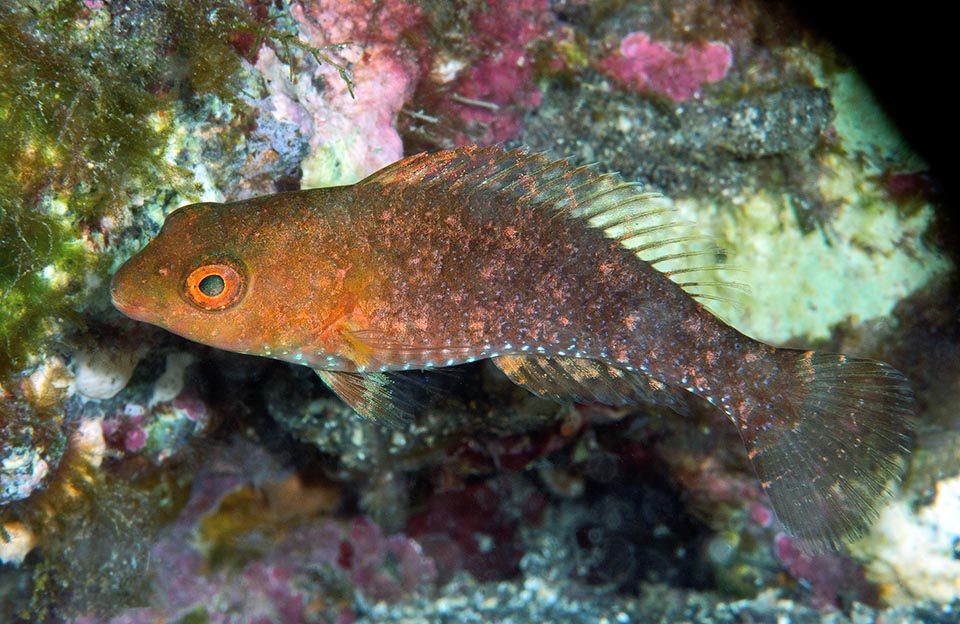
The floating eggs and the larvae are pelagic for about two months. The young livery shows brown orange shades, and intially often two clear lines on the sides © Belén Caro
The juvenile livery displays brown, orange shades, and initially two clear lines on the sides.
Much fished for feeding in the Roman times, nowadays the Mediterranean Parrotfish is no longer required by the market. Therefore, it can sleep calmly on the bottom, with a good resilience, seeing the possible doubling of the populations in 1,4-4,4 years and a moderate vulnerability index marking presently, in 2021, only 36 on a scale of 100.
Synonyms
Scarus turchesius Valenciennes, 1840; Scarus pleianus Poey, 1861.
→ For general information about FISH please click here.
→ For general information about BONY FISH please click here
→ For general information about CARTILAGINOUS FISH please click here.
→ To appreciate the BIODIVERSITY of BONY FISH please click here.
→ To appreciate the BIODIVERSITY of CARTILAGINOUS FISH please click here.
